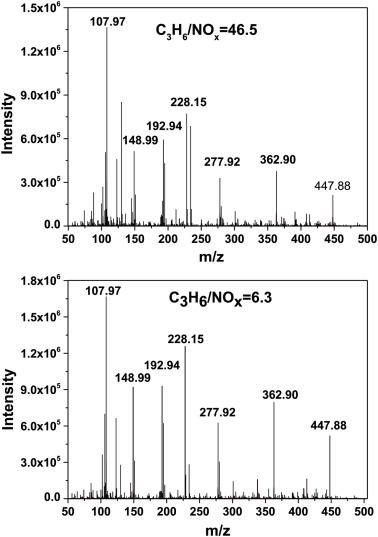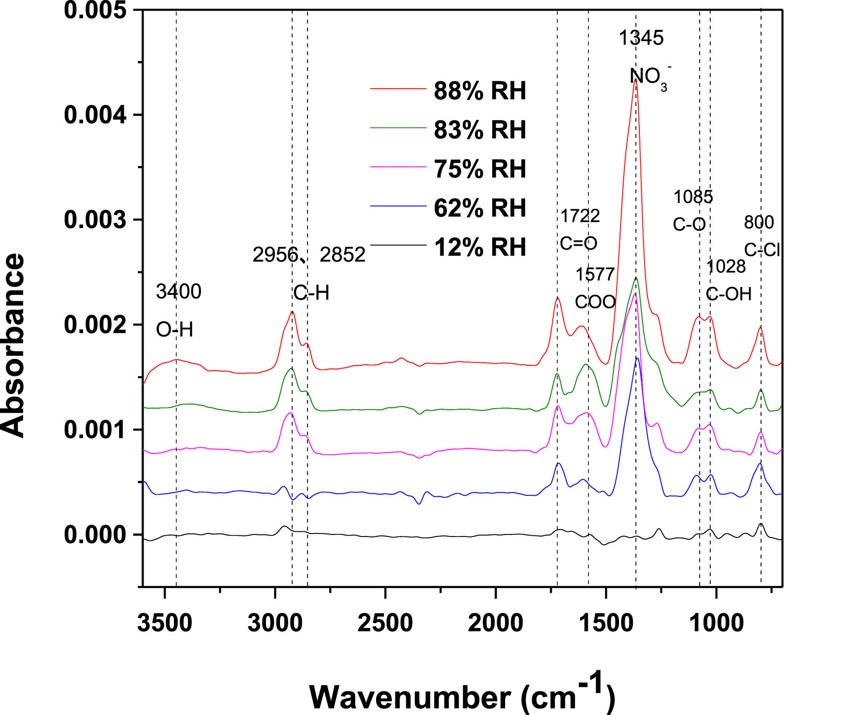组内消息
2017-03-13
Secondary organic aerosol formation from propylene irradiations in a chamber study
通过烟雾箱实验证实丙烯可以在颗粒水中生成二次有机气溶胶,并发现NaCl颗粒中Cl参与了二次有机颗粒物的形成。
Highlights:
1.Formation of SOA from propylene is confirmed for the first time.
2.Main chemical compositions of propylene SOA are determined.
3.Participation of Cl atoms in the formation of SOA is determined.

ESI-Exactive-Orbitrap MS results of SOA from propylene
Full text on line
Ge Shuangshuang, Xu Yongfu, Jia Long. Secondary organic aerosol formation from propylene irradiations in a chamber study. Atmospheric Environment, DOI:10.1016/j.atmosenv.2017.03.019
组内消息
2017-02-15
Photooxidation of cyclohexene in the presence of SO2: SOA yield and chemical composition
Abstract. Secondary organic aerosol (SOA) formation from cyclohexene/NOx system with various SO2 concentrations under UV light was studied to understand the effects of cyclic alkenes on the atmospheric environment in polluted urban areas. A clear decrease at first and then increase of the SOA yield was found with increasing SO2 concentrations. The lowest SOA yield was obtained when initial SO2 concentration was in the range of 30–40 ppb, while higher SOA yield compared to that without SO2 could not be obtained until the initial SO2 concentration was higher than 85 ppb. SOA formation was enhanced by the acid-catalyzed heterogeneous reactions, which lead to an increase in the total organic aerosol mass. The competitive reaction of OH radicals with SO2 and VOCs was the reason for the SOA yield decrease even under acidic conditions. The competitive reaction was an important factor for SOA yield and it should not be neglected in photooxidation, especially when acid-catalyzed mechanism could not significantly improve SOA yield. The composition of organic compounds in SOA was measured using several complementary techniques including Fourier transform infrared (FTIR) spectrometer, ion chromatograph (IC) and electrospray ionization high-resolution quadrupole mass spectrometer (ESI-HR-MS). We present the first evidence that organosulfates were produced from the photooxidation of cyclohexene in the presence of SO2.
Full text
Citation: Liu, S., Jia, L., Xu, Y., Tsona, N. T., Ge, S., and Du, L.: Photooxidation of cyclohexene in the presence of SO2: SOA yield and chemical composition, Atmos. Chem. Phys. Discuss., doi:10.5194/acp-2017-30
组内消息
2017-02-06
Highlights:SOA formation is greatly enhanced with liquid NaCl droplets.

Abstract:Secondary organic aerosol (SOA) formation from the gas-phase ozonolysis of ethylene without irradiation was studied at different levels of relative humidity (RH) in both absence and presence of sodium chloride (NaCl) in a Teflon bag reactor. Results show that a small amount of SOA was formed from the ethylene ozonolysis in the absence of NaCl. When NaCl was in the form of liquid droplets, much more SOA could be formed. With the initial concentrations of 1 ppm and 0.5 ppm for ethylene and ozone, SOA concentrations of 3.0 to 8.6 μg/m3 were obtained after 5-h reactions under RH levels of 62% to 88% in the presence of NaCl seed particles, which were about 3~9 times higher than the results from the experiments without NaCl. The yield of SOA also increased with increasing RH, with the value being 3.0% at 88% RH in the presence of NaCl. Addition of the scavenger of OH radicals (n-hexane, ~900ppm) into the reaction system at 86% RH resulted in the decrease of the SOA yield by 21%. The liquid water content in aerosols was a key factor to SOA formation in the presence of different seed particles, including NaCl and Na2SO4. An analysis of the SOA with a Fourier-transform (FT) IR spectrometer shows that the particles formed from the ethylene ozonolysis were organic compounds that contained the functional groups of O–H, C=O, C–O, C–Cl and C–OH. The heterogeneous aqueous reaction is probably an effective pathway to form SOA from the ethylene ozonolysis, which should be considered in the atmosphere.
Ge Shuangshuang, Xu Yongfu, Jia Long, Secondary organic aerosol formation from ethylene ozonolysis in the presence of sodium chloride, Journal of Aerosol Science, doi:10.1016/j.jaerosci.2017.01.009.
Full text
- « PREV
- 1
- ...
- 4
- 5
- 6
- 7
- 8
- 9
- NEXT »






